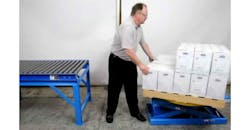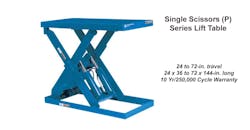Talking about automation is like the material handling world’s version of celebrity gossip. These systems employed by Amazon and the like are flashy, fast, and waaay out of your price range. And they may not be as prevalent as the technology hype-mongers would have you think.
For instance, as many benefits as automated storage and retrieval system provide, they are expected to increase 6% a year worldwide, reaching $17.9 billion worldwide, according to The Freedonia Group.
Global Industry Analysts, Inc. projects the material handling equipment market (MHEM) will be $134.8 billion in 2020, so this means after growing nearly 25%, automated storage and retrieval systems will only account for 13% of MHEM overall.
That’s not bad for relatively new and expensive approach to material handling, but it looks like it will only impact large companies. The Freedonia Group acknowledges in its report that most small and medium-sized companies will rely on manual material handling.
“If you have the capital to afford an automated system and that’s what you want, that’s what you’re going to go with,” says Michael Renken, vice present of Advance Lifts.
"Automated systems can cost tens to hundreds of thousands of dollars, he continues. “For many, the automated system is great until you see the price, and you fall over backwards.”
Advance Lift’s self-leveling lifts can cost only $1,500 he adds.
“For the small guy, automation is cost prohibitive,” Renken says.
This is why, for all the hype, Renken believes the “human aspect is still very important at just about all levels,” and why Advance Lift’s self-leveling palletizers are still a good investment in an increasingly automated material handling environment.
These tables are sprung to intuitively keep the boxes at an optimal height for the worker to grab and place on a conveyor or lift truck.
The load capacity ranges from 2,500 to 4,000 lb, based on if it’s powered pneumatically, electrically, or mechanically.
They also rotate so the handler doesn’t have to move around when one side is clear.
“You take a few boxes off, rotate it, and then take a few more off,” Renken explains. “As the load gets lighter, the unit adjusts the height to keep boxes near an ergonomic position.”
Sure, your workers will appreciate the equipment that makes their job easier, but it’s also an investment that prevents serious avoidable costs down the line.
“With repetitive motion at incorrect height, you’re open for injury,” Renken says. “The price of a lift table is nothing compared to workman’s comp.”
And even for bigger companies implementing automated material handling solutions, these “down and dirty” lifts can assist in achieving high production efficiency. If in a day, your warehouse uses robots to load or depalletize the majority of your uniform sized materials, yet has 10 pallets of odd-sized products, a human worker would probably be needed.
While the company’s products most obviously support human functions, their Production Series lift tables, which can have accuracies down to 0.030-in. repeatability, have integrated into human-free material handling environments as well.
In a tire manufacturer’s complicated conveyor system that required a height change every 40 sec., 18 of these scissor lifts were used, creating a connected 18-level serpentine track to transfer the pallets.
And for all the innovations in accuracy and speed, Renken says warehouses are “nowhere near a point of reasonable automation.”
“That’s because a person can see damage, and can adjust to minute differences,” he says, “where automate machinery has zero tolerance for a change.”
About the Author
John Hitch
Editor, Fleet Maintenance
John Hitch, based out of Cleveland, Ohio, is the editor of Fleet Maintenance, a B2B magazine that addresses the service needs for all commercial vehicle makes and models (Classes 1-8), ranging from shop management strategies to the latest tools to enhance uptime.
He previously wrote about equipment and fleet operations and management for FleetOwner, and prior to that, manufacturing and advanced technology for IndustryWeek and New Equipment Digest. He is an award-winning journalist and former sonar technician aboard a nuclear-powered submarine where he served honorably aboard the fast-attack submarine USS Oklahoma City (SSN-723).


